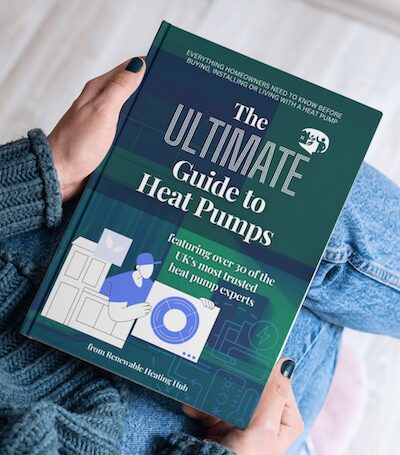@johnmo An AroTHERM 12-14 kW ASHP can draw 23.3 amps so let's say your big old stone manse with its outbuildings needs two of those and you have an EV, electric showers and everything else then I could imagine you pushing 60 amps peak. Correct me if I'm wrong but in some rural areas with overground electricity distribution then isn't that the distribution maximum per property per phase?. Something would need to be done, either run a heavier cable from the nearest transformer or pick up a second phase. Certainly here I was asked what was my supply rating and the issue went away when I showed the installer a sticker saying "100A". Extreme maybe but not impossible.
Posted by: @dr_dongleAn AroTHERM 12-14 kW ASHP can draw 23.3 amps so let's say your big old stone manse with its outbuildings needs two of those and you have an EV, electric showers and everything else then I could imagine you pushing 60 amps peak.
So using your stretching thing out of all proportions example.
Your aerotherm draws a max of 23.3A, it doesn't draw that all the time. Why would you have electric showers when you have a heat pump, let alone two you are describing.
I am in a rural area pulling from a box on a pole we have a 100A also.
So even with the extreme example you pose, there would still 40A (9kW) of spare capacity.
As I said no idea why a domestic property needs 3 phase.
Posted by: @dr_dongle@johnmo An AroTHERM 12-14 kW ASHP can draw 23.3 amps so let's say your big old stone manse with its outbuildings needs two of those and you have an EV, electric showers and everything else then I could imagine you pushing 60 amps peak. Correct me if I'm wrong but in some rural areas with overground electricity distribution then isn't that the distribution maximum per property per phase?. Something would need to be done, either run a heavier cable from the nearest transformer or pick up a second phase. Certainly here I was asked what was my supply rating and the issue went away when I showed the installer a sticker saying "100A". Extreme maybe but not impossible.
So if you had the heat pump drawing 23 Amps and two 7kW electric showers each drawing 29 Amps, plus a 7kW EV charger also drawing 29 Amps, even without any further household loading the peak current would be in the region of 110 Amps.
Obviously if you don't try to use all these items at the same time then the loading will be much lower. This is where some forward thinking, planning ahead, and common sense come into play.
One of the problems with ToU tariffs is that they can encourage consumers to switch too many high power devices on at the same time, which may be useful in helping move peak demand on the high voltage grid, but in turn can cause overloading of the local distribution network and consumers home system. I suspect that this will get worse as more consumers install heat pumps, EV chargers and battery storage systems.
16kW ASHP and two electric showers - why? Would assume someone getting that size heat pump would be via a grant, so your hot water has to come from the heat pump, not produced on demand. So again you are well below 100A, so you can put the kettle on as well.
@derek-m .. Of course though *you* may forward plan it doesn't follow that the next person does and the utility companies have to add a safety margin. Also as you say, if you turn on a large piece of plant in a system that is stressed already then the results can be felt elsewhere. A couple of years ago SSEN was climbing all over the local network to see who was turning on big crop dryers when they shouldn't have been and the voltage in the area was all over the place.
Planning for a stressed network was part of the reason we went for a hybrid ASHP system including a small modern oil boiler.
Posted by: @dr_dongle@derek-m .. Of course though *you* may forward plan it doesn't follow that the next person does and the utility companies have to add a safety margin. Also as you say, if you turn on a large piece of plant in a system that is stressed already then the results can be felt elsewhere. A couple of years ago SSEN was climbing all over the local network to see who was turning on big crop dryers when they shouldn't have been and the voltage in the area was all over the place.
Planning for a stressed network was part of the reason we went for a hybrid ASHP system including a small modern oil boiler.
I would hope that most energy consumer's, if the problems were adequately explained, along with the fact that it may help keep their bills lower, would try to spread their energy use throughout the day. Obviously there will always be the selfish 'bad apple', who insists on heating their swimming pool, hot tub and charge their numerous EV's all at the same time, but hopefully their service fuse will blow and they will see the point.
I'm afraid I don't know any homeowners with a big crop dryer, but I am surprised it is using electric heating rather than some more efficient way. Maybe solar PV or even solar thermal would be a better way to dry their crops.
@derek-m Ah now… I can assist here! In the 1960’s, my brother was an apprentice electrician; we lived in Yeovil, Somerset and most of the work my brother carried out was on farms and agricultural premises. He did indeed visit many grain dryers and they were all powered by three phase mains.
I also recall he spent many a happy hour on new projects with heavy machinery along with milk pasteurising equipment, sterilising equipment along with fluorescent lighting and had to balance the load and reduce lag in the resistive and inductive loads so that they remained friends with their DNO! Regards, Toodles.
Toodles, heats his home with cold draughts and cooks food with magnets.
I might also add that my brother was called out to farms occasionally after a grain dryer fire; as you might imagine, dust from the grain drying process would accumulate occasionally and less than scrupulous farmers found themselves on the expensive end of a repair bill! Regards, Toodles.
Toodles, heats his home with cold draughts and cooks food with magnets.
Apologies for arriving 'late' to this topic.
Posted by: @editorCould you advise on whether a single-phase or three-phase electricity supply would be best suited for our situation?
Additionally, what are the key differences between single-phase and three-phase electricity in the context of residential use, especially considering the high electrical demand from the heat pump and the potential addition of an EV charger?
We've been discussing the change from single-phase to 3-phase over here on a topic about DIY Solar upgrade...
Two of the respondents, @bretix and @david999 , have had their homes upgraded to three-phase.
In both cases, the electricians still ran the in-house wiring as if it was a single-phase supply.
The reason the DNO changes a house to 3-phase is not merely to provide more power.
At its heart, the 3-phase upgrade needs to be seen as having an obligation to spread the loads across those phases.
Failing to do so means that the local substation continues to have significant energy losses.
I gave an overview of what effects occur on the local grid when we have single-phase homes connected to a 3-phase substation. If you want to dive straight into that part of the discussion then start here at Page-12.
What we implement in our homes needs to be 'grid friendly'.
If we don't do that, then the DNO will need to upgrade the Low Voltage (LV) local grid to provide greater headroom.
That's extremely expensive and would need to be funded by high bills.
From the perspective of the DNO, LV supplies are 11kV, which supply power to the local substations, and 240v/440v which runs to our homes.
Save energy... recycle electrons!
To make full use of a 3 phase supply with regard to balancing the loading on each phase, all high demand equipment such as heat pumps, EV chargers, battery storage systems etc. would need to be capable of accepting a 3 phase supply. The remaining household loads could be connected to one of the phases, or if excessive, distributed across the 3 phases.
Anyone contemplating upgrading to a 3 phase supply would be advised to do so before any of the above high demand equipment is to be installed.
Posted by: @transparentAt its heart, the 3-phase upgrade needs to be seen as having an obligation to spread the loads across those phases.
But your local electrician may just stick phase 1 to same location on every house, so zero net gain for the grid. Your grid man/women up the pole or at the mains junction box (or their leader) should easily identify what is connected to what phase at their end and balance automatically prior to hitting the house. By connecting to mixed phases. Advocating everyone needs 3 phase is nonsense.
Posted by: @derek-mAnyone contemplating upgrading to a 3 phase supply would be advised to do so before any of the above high demand equipment is to be installed.
Yes!!
I absolutely agree.
3-phase heat pumps and EV chargers would be so much better for the local distribution grid.
Posted by: @AnonymousBut your local electrician may just stick phase 1 to same location on every house, so zero net gain for the grid.
Sad, but true.
That approach is a failure to understand electricity from the viewpoint of the grid.
We need more enlightened electricians...
...who might even be prepared to listen to a customer who's read what we've discussed here on the Forum.
We need to give our electrician the opportunity to change.
After all, it may just be a phase he's going through.
Save energy... recycle electrons!
- 26 Forums
- 2,342 Topics
- 53 K Posts
- 297 Online
- 6,000 Members
Join Us!
Worth Watching
Latest Posts
-
RE: Octopus Cosy Heat Pump Owners & Discussion Thread
@harrisonc mine has level 3 MID monitoring and you can ...
By swwils , 36 minutes ago
-

RE: Heat Pump Heats the House… But It’s Not Cosy. Emitter Changes or System Tweak?
@alastair, in short, no, increasing emitter capacity wo...
By Mars , 1 hour ago
-
RE: Setback savings - fact or fiction?
Hi @cathoderay - this is a good discussion! I feel like...
By RobS , 2 hours ago
-

RE: Free Ecoheat Heat Pump Install
@deltona happy to help as much as I can if you decide t...
By bontwoody , 2 hours ago
-

RE: Are We Sleepwalking Into Another Race to the Bottom?
I'll be honest, I love that idea! I'll start working on...
By Mars , 3 hours ago
-
RE: Configuring third party dongle for Ecodan local control
@majordennisbloodnok I think the HPDHD diagnosis may be...
By Sheriff Fatman , 4 hours ago
-

RE: External pipework insulation
I don't think we can tell from a photo whether your exi...
By Transparent , 4 hours ago
-
Advice on internal circulation pump noise
Hi all - I wanted to share my recent experience of a do...
By jtg , 10 hours ago
-
RE: Controlling Daikin Altherma via P1P2 and Home Assistant
@majordennisbloodnok That’s correct. I can’t find anywh...
By weoleyric , 10 hours ago
-

RE: A Smarter Smart Controller from Homely?
@papahuhu I hope you get a swift resolution. Regards, T...
By Toodles , 1 day ago
-

RE: Poll for Time of Use, tariffs, technology
That’s fine by me too Major, I feel it is a sad reflect...
By Toodles , 1 day ago
-

Bingo. Sometimes a judiciously placed size 10 bovver bo...
By Majordennisbloodnok , 1 day ago
-
RE: Mitsubishi Ecodan 11.2kW heat pump with low COP
@ciocoiu-alexandru I can't provide the same level of di...
By Sheriff Fatman , 1 day ago
-

The three technical issues I'm considering are: BMS...
By Transparent , 1 day ago
-
RE: LiFePO4 lithium battery fires and explosions
@transparent Your post may fit better in th...
By Batpred , 2 days ago
-

RE: British Gas vs Octopus Energy vs Heat Geek vs EDF vs Aira vs OVO vs EON.Next vs Boxt
@jamespawhite, if you could be bothered, you could also...
By Mars , 2 days ago
-
RE: Commencing on an ASHP Installation Process
I've got a bit of time to draft something today, so the...
By Sheriff Fatman , 2 days ago
-
RE: Help with heat pump sizing
@amin I dont think materially relative to t...
By JamesPa , 2 days ago




